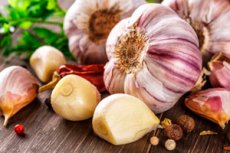New publications
Garlic as a powerful remedy against atherosclerosis
Last reviewed: 02.07.2025

All iLive content is medically reviewed or fact checked to ensure as much factual accuracy as possible.
We have strict sourcing guidelines and only link to reputable media sites, academic research institutions and, whenever possible, medically peer reviewed studies. Note that the numbers in parentheses ([1], [2], etc.) are clickable links to these studies.
If you feel that any of our content is inaccurate, out-of-date, or otherwise questionable, please select it and press Ctrl + Enter.

In a recently published study in Frontiers in Pharmacology, researchers from China identified and analyzed the active components of garlic and their targets in atherosclerosis, exploring the underlying pharmacological mechanisms. They found that garlic reduced the expression of ferroptosis-related genes, indicating its potential to treat atherosclerosis by regulating ferroptosis and reducing lipid peroxidation.
Atherosclerosis is a leading cause of cardiovascular disease (CVD), such as coronary heart disease and stroke, with abnormal intimal thickening of the carotid arteries affecting over a billion people worldwide. The disease results from abnormal lipid metabolism, leading to plaque formation and potential closure of arteries due to plaque rupture. Emerging evidence highlights the role of ferroptosis, a form of regulated cell death associated with lipid peroxidation, in atherosclerosis and other CVD. Although lipid-lowering drugs are available, they carry risks such as liver and kidney damage, highlighting the need for safer treatments.
Garlic, widely used as a herbal supplement, is known for its cardiovascular benefits, especially in reducing oxidative stress and inflammation, which are critical factors in atherosclerosis. Its active components, such as allicin, can inhibit lipid peroxidation and ferroptosis. Despite its known benefits, the exact mechanisms by which garlic affects atherosclerosis remain unclear. Network pharmacology and molecular docking techniques can be used to study the multi-target mechanisms of garlic, with the aim of developing new, effective drugs for the prevention and treatment of atherosclerosis. In this study, the researchers investigated the mechanisms by which garlic improves atherosclerosis using a combination of network pharmacology, bioinformatics, molecular docking, and experimental validation.
The major pharmacological targets and active components of garlic, collectively referred to as garlic-related drug targets, were retrieved from three databases: Traditional Chinese Medicine Systems Pharmacology Database (TCMSP), Traditional Chinese Medicine Information Database (TCM-ID), and Encyclopedia of Traditional Chinese Medicine (ETCM). Potential atherosclerosis target genes were retrieved from the following databases: DisGeNET, GeneCards, and DiGSeE. An intersection analysis of these data was performed to identify potential garlic target genes for the treatment of atherosclerosis. Gene Ontology (GO) and Kyoto Encyclopedia of Genes and Genomes (KEGG) enrichment analyses were performed for these genes. An interaction network between garlic components, therapeutic targets, and major signaling pathways was constructed. The differences in arterial gene expression between healthy individuals and those with atherosclerosis were analyzed using different databases. In addition, molecular docking of active components of garlic with key genes was carried out.
Experimental validation included cell experiments with mouse cells to evaluate cytotoxicity, biochemical assays, oil red O staining, and Western blotting. Reverse transcription-quantitative polymerase chain reaction (RT-qPCR) was performed to measure gene expression levels. The mouse models were then divided into four groups: sham-operated group, model group, allicin-treated group, and negative control group. Serum biochemical assays and histological changes were observed.
A total of 16 active components of garlic and 503 potential targets were identified. In addition, 3033 key targets for atherosclerosis were found. As a result of the intersection of garlic targets with atherosclerosis targets, 230 potential therapeutic targets were identified. Pathway enrichment analyses revealed 2017 biological processes, 78 cellular components, and 200 molecular functions. Significant processes included oxidative stress response and inflammation. Potential targets were found to be enriched in lipid metabolism and atherosclerosis pathways.
Molecular docking studies have shown that garlic components such as sobrole A, benzaldoxime, allicin and (+)-L-alliin strongly interact with ferroptosis-related proteins such as GPX4 (glutathione peroxidase), DPP4 (dipeptidyl peptidase 4) and ALOX5 (arachidonate 5-lipoxygenase). In animal models, especially apolipoprotein E knockout mice and C57BL/6 mice, allicin has been shown to significantly reduce plaque formation and lipid deposition in the carotid artery. Allicin also improved lipid profiles by reducing low-density lipoprotein (LDL-C), total cholesterol and triglyceride concentrations in the treated group compared to the untreated group. Allicin reduced lipid peroxidation and iron-induced cell death as evidenced by decreased malondialdehyde levels and increased GPX4 in serum.
In vitro experiments, allicin reduced oxidative damage induced by ox-LDL. The protein expression of ferroptosis-related genes DPP4 and ALOX5 was decreased by allicin treatment, while GPX4 expression was increased. In addition, allicin decreased ALOX5 mRNA levels and increased GPX4 mRNA levels compared with the ox-LDL group. These results indicate that garlic, especially allicin, may improve atherosclerosis by regulating ferroptosis, highlighting its potential therapeutic value in the management of CVD.
In conclusion, the study highlights the potential of garlic and its active compounds such as sobrol A, allicin, (+)-L-alliin and benzaldoxime in the treatment of atherosclerosis by targeting ferroptosis-related mechanisms. The specific target genes identified in the study provide a basis for the development of targeted therapies that may improve treatment outcomes in the future. The findings call for further research into garlic-based therapies that may lead to more effective, natural treatment options for CVD.
